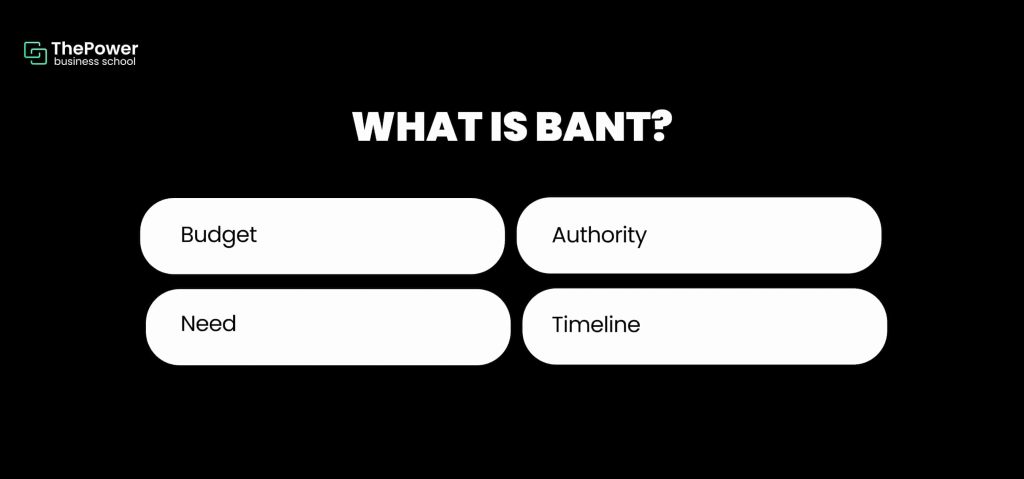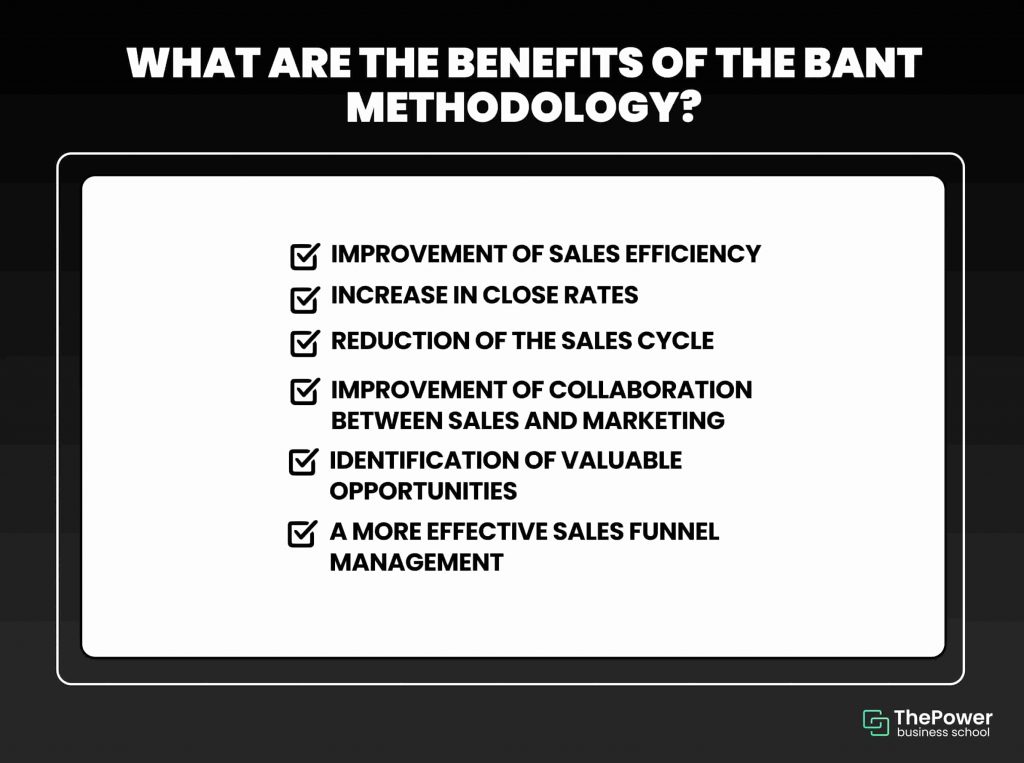BANT methodology, the efficient way to identify prospects
In the world of marketing and sales, identifying and focusing on the highest potential opportunities is essential for success, especially if you are looking to generate quick wins.
In pursuit of this, the BANT methodology emerges as a valuable tool that provides a systematic and effective approach to qualify prospects and guide them through the buying process.
Although somewhat old, it’s a reliable and effective resource that has already proven its ability to optimize sales efforts and improve conversion rates, but if you are not familiar with it, you may find it difficult to incorporate it into your company's methodology.
What is BANT?
BANT is an acronym used in sales and marketing to qualify and evaluate sales opportunities, which was popularized by IBM in the 1960s as an approach to identify whether a prospect or lead can be considered qualified and therefore has a high potential to become a customer.
Being an acronym, each letter represents a definition:
1. Budget
At this stage, you assess whether the prospect has the financial resources to purchase the product or service you are offering, so the objective is to determine whether the prospect can afford to buy what you are selling.
Imagine that as a company you sell business management software. If the prospect has a limited budget and cannot invest in expensive solutions at a given time, they may not meet the budget criteria.
2. Authority
Here you seek to understand if the prospect has the authority and ability to make purchasing decisions. It’s important to identify if the prospect is the key person who can give the green light to the purchase without relying on the approval of others.
If you are selling consulting services for a company, you need to talk to someone who has the authority to make strategic decisions. If, on the contrary, you're talking to a lower-level employee who can't make purchasing decisions, you don't meet the authority criterion.
3. Need
In this phase, you investigate whether the product or service you are offering satisfied a specific need of the prospect, as it’s about understanding the challenges and problems the prospect faces and how your offers can solve them.
If you sell digital marketing services, it's important to find out if the prospect's focus is on increasing their online visibility. If the prospect does not have any digital marketing-related needs, they do not meet the need criterion.
4. Timeline
Here we inquire about the prospect's timeline or urgency to make the purchase. We seek to understand if there is a deadline or a specific time when the purchase must be completed.
We go back to a software example, but in cyber security where the prospect is looking for a solution before a security audit in two months. This would meet the timeline criterion. On the other hand, if there’s no defined timeline and the prospect is not in a hurry to acquire the solution, the case doesn’t meet this criterion.

Why is BANT a good methodology for companies?
The idea behind BANT is that if a prospect meets these four criteria, then he/she is more likely to be a solid sales opportunity for the company, making it worth investing time and resources in.
However, it’s important to mention that the BANT approach has evolved over time and therefore does not fit all types of sales and contexts. Today, many sales professionals use more flexible approaches that are better suited to the specific needs and characteristics of each prospect.
But this does not prevent you from using the methodology created by IBM to increase sales in a company, because yes, it may be an old approach, but it has a proven usefulness, credibility and success rate.
What are the benefits of the BANT methodology?
As any strategy that can be adopted by a company, it provides certain benefits, such as increasing sales, which is the main focus of the brands, especially those in competitive markets, where the need to stand out is important. So applying the BANT methodology guarantees:
1. Improvement of sales efficiency
By focusing on prospects that meet budget, authority, need and schedule criteria, sales teams can devote more time and resources to opportunities that have a higher potential to become successful sales.
This avoids wasted effort on prospects that are not ready or do not intend to buy at that time. By prioritizing and directing resources to high quality opportunities, efficiency is maximized and a more effective use of salespeople's time is achieved.
2. Increase in close rates
Prospects who meet BANT criteria are further along in their buying process. They have the necessary budget, the authority to make decisions, a real need and an established timeline.
Because of their level of readiness, these prospects are more inclined to make positive decisions and move toward a purchase.
As a result, closing rates tend to be higher for BANT-compliant prospects compared to those who are not.
3. Reduction of the sales cycle
Because you’re working with prospects who already have an identified need and a timeline for making a decision, the sales cycle tends to be shorter. These prospects don't need to go through a lengthy education or evaluation process, as they are already clear on what they need and are ready to move forward.
This is how sales teams are enabled to accelerate the process and close deals more efficiently and with greater immediacy, which can have a positive impact on productivity and revenue.
4. Improvement of collaboration between sales and marketing
This methodology provides a clear structure for defining and communicating which prospects are most valuable and deserve the most attention, which facilitates alignment between sales and marketing teams, as both can focus on attracting, nurturing and converting prospects that meet BANT criteria.
This collaboration improves the effectiveness of lead generation efforts across departments within a company, ensuring that resources are used strategically to achieve sales goals.
5. Identification of valuable opportunities
It helps identify sales opportunities that have greater potential to generate significant revenue for the company because by focusing on prospects who have the ability and desire to buy, sales teams can identify opportunities that are aligned with the organization's growth and profitability objectives.
The result is that within the company there is a more strategic allocation of resources and efforts to maximize sales ROI, which can mean increased profits.
6. Improvement of prospect qualification
It provides a clear and objective framework for qualifying prospects, as the BANT criteria help salespeople systematically assess whether a prospect is a valuable opportunity.
This avoids spending time on prospects who do not meet the essential requirements for a successful sale. Effective qualification through BANT helps sales teams focus on the prospects that are most likely to move forward in the sales process.
7. A more effective sales funnel management
It can be applied at different stages of the sales funnel, making it easier to categorize and prioritize opportunities based on their progress and alignment with BANT criteria.
This allows sales teams to more effectively manage lead flow and understand where they are in the process. By having clarity on which prospects are BANT compliant, sales teams can make informed decisions on how to allocate resources and how to move forward with each opportunity.

How to apply the BANT methodology in the sales process?
Applying the BANT methodology in the sales process involves incorporating the criteria into interactions with prospects and customers throughout each stage of the sales cycle. While everyone can do it differently, here is a step-by-step on how it could be done:
1. Research and prospecting
This stage is where you research and select prospects that appear to be promising for the brands' and/or companies' objectives. This is done by using available information to determine if they fit the BANT criteria before investing time in direct contact.
2. First contact and initial qualification
During the first contact with a prospect you begin to assess whether they meet the BANT criteria, but to find out if they do you can ask these questions:
Budget: ask about the budget available to solve the problem or need.
Authority: find out who makes purchasing decisions and what their level of authority is.
Need: explore the challenges or problems the prospect faces and how your product/service could help.
Timeline: inquire about the timeframe in which they need a solution.
3. Presentation and Demonstration
As you move through the sales process, delve deeper into the criteria of the BANT methodology. Use presentation and demonstration to verify if the prospect meets the requirements:
Confirm that the prospect has the budget to purchase the solution.
Make sure you are talking to the person who has the authority to make decisions.
Highlight how your product/service addresses the prospect's specific need.
Discuss the prospect's timeline and how your solution might fit into their timeframe.Handling objections
During this stage, handle any objections that arise related to the BANT criteria. For example, if the prospect mentions that their budget is limited, explore financing options or smaller edits to fit their budget, if and when possible.
4. Negotiating and closing
As you approach closure, you need to start reinforcing how your solution meets the BANT criteria, which you can do in each of the 4 stages of the methodology:
Reaffirm that the budget is manageable and that the benefits outweigh the costs.
Confirm that the prospect has the authority to make the final decision.
Highlight how your product/service effectively addresses the need.
Establish a clear timeline for implementation and delivery.
5. Post-sale follow-up
After closing the sale, ensure that implementation and delivery meet the customer's expectations in terms of need and timeline. Maintain communication to strengthen the relationship.
What can we conclude about the BANT methodology?
We can say that it has already proven to be much more than just an acronym, in fact, that’s why it stands as a reliable compass in the world of sales, as it works as a guide for sales teams towards greater efficiency and success.
As we have explored the pillars that make up BANT: budget, authority, need and timeline, it is clear that this methodology not only qualifies prospects, but also acts as a filter that distills the most valuable opportunities aligned with the company's objectives.
Now, the implementation of BANT depends on you, so that as a salesperson of a product and/or service, you focus on the prospects that are closest to making buying decisions, so are you ready to maximize your sales? Let us know in the comments.





